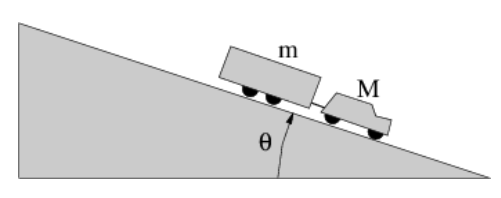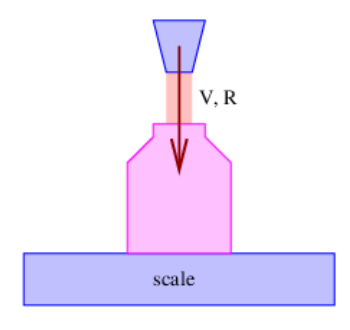10.6: Problems
( \newcommand{\kernel}{\mathrm{null}\,}\)
- Imagine a block of mass M resting on a plate under the influence of gravity, as shown in Figure 10.6.7:.
- Determine the force of the plate on the block, Nb, and the force of the block on the plate, Np.
- State which of the three forces, Mg,Nb, and Np, form a Newton’s third law pair.
 Figure 10.6.7:: Block of mass M subject to gravitational force Mgwhile resting on a plate. The force of the block on the plate is Np while the force of the plate on the block is Nb.
Figure 10.6.7:: Block of mass M subject to gravitational force Mgwhile resting on a plate. The force of the block on the plate is Np while the force of the plate on the block is Nb.
- Repeat the previous problem assuming that the block and the plate are in an elevator accelerating upward with acceleration a.
- Straighten out the misunderstanding of Newton’s third law implicit in the question “If the force of the horse on the cart equals the force of the cart on the horse, why does anything ever go anywhere”? Examine in particular the conditions under which the horse-cart system accelerates.
- A pusher boat (mass M) on the Mississippi is pushing two barges (each mass m) at a steady speed as shown in Figure 10.6.8:. Each barge is subject to a drag force by the water of FB. Consider only horizontal force components in the following.
- What is the total horizontal force of the water on the barge-boat system? Explain.
- What is the direction and magnitude of the force of the pusher boat on barge 1? Explain.
 Figure 10.6.8:: Barges being pushed by a pusher boat on the Mississippi. Each barge experiences a drag force Fb.
Figure 10.6.8:: Barges being pushed by a pusher boat on the Mississippi. Each barge experiences a drag force Fb.
- A train with an engine of mass M and 2 freight cars, each of mass m, is accelerating to the right with acceleration a on a horizontal track as shown in Figure 10.6.9:. Assume that the two freight cars roll with negligible friction. Consider only horizontal force components below.
- Find the direction and magnitude of the force of the rails on the engine and specify the system to which Newton’s second law is applied.
- Find the direction and magnitude of the force of the engine on the first car and specify the system to which Newton’s second law is applied.
- Find the direction and magnitude of the force of the first car on the second car and specify the system to which Newton’s second law is applied.
- Find the direction and magnitude of the force of the second car on the first car and specify the law used to obtain this force.
 Figure 10.6.9:: An engine and two freight cars accelerating to the right.
Figure 10.6.9:: An engine and two freight cars accelerating to the right.
- A car and trailer are descending a hill as shown in Figure 10.6.10:. Assume that the trailer rolls without friction and that air friction can be ignored. Consider only forces parallel to the road surface.
- Compute the force of the road on the car if the car-trailer system shown in Figure 10.6.10: is moving down the hill at constant speed.
- Compute the force of the trailer on the car in the above conditions.
- If the driver takes his foot off the brake and lets the car coast frictionlessly, recompute the force of the trailer on the car.
 Figure 10.6.10:: A car and a trailer going down a hill.
Figure 10.6.10:: A car and a trailer going down a hill.
- Consider a one-dimensional elastic collision between particles of masses m1 and m2. If particle 2 is initially stationary, what range of values must m1/m2 have for the initial particle to rebound backwards along its initial track after the collision? (Do this problem non-relativistically.)
- A stationary pion (mass M) decays into a muon (mass m<M)) and a neutrino (massless).
- What is the (fully relativistic) momentum of the muon after the decay?
- What is the energy of the neutrino?
- In an elastic collision viewed in the center of momentum frame, the energy of each particle is conserved individually. Is this true for the same process viewed from a reference frame in which one of the particles is initially stationary?
- A space probe approaches a planet in the -x direction, curves around it under the influence of the planet’s powerful gravity (a conservative force) and recedes from the planet in the +x direction, as seen in Figure 10.6.11:. The planet is moving in the +x direction at speed V , while the space probe is initially moving in the -x direction at speed u1. What is its speed u2 in the +x direction after this close approach to the planet? Treat this problem nonrelativistically. Hint: First transform to the center of mass frame in which the planet is essentially stationary. Work out the interaction between the probe and the planet in this frame. Then transform back to the original reference frame. Assume that the mass of the probe is negligible compared to that of the planet.
 Figure 10.6.11:: A space probe approaches a planet, curves around it, and heads off in the opposite direction.
Figure 10.6.11:: A space probe approaches a planet, curves around it, and heads off in the opposite direction. - Two asteroids, each with mass 1010 kg and initial speed 105 m s-1, collide head on. The whole mess congeals into one large mass. How much rest mass (rest energy divided by c2) is created?
- Two equal objects, both with mass m, collide and stick together. Before the collision, one mass is stationary and the other is moving at speed v. In the following, assume that velocities are fully relativistic.
- Compute the total momentum and energy (including rest energy) of the two masses before the collision.
- Compute the mass M of the combined system after the collision, taking the conversion of energy into mass into account.
- Explain qualitatively why a fireman needs to push forward on a firehose to keep it stationary. Hint: The water is flowing faster after it comes out of the nozzle of the hose than before.
- Solve equation (10.19) for V as a function of m, assuming that V=0 and m=m0 at t = 0. Hint: Since R=−dm/dt, we have R/m=−dln(m)/dt.
- Bottles are filled with soft drink at a bottling plant as shown in Figure 10.6.12:. The bottles sit on a scale which is used to determine when to shut off the flow of soft drink. If the desired mass of the bottle plus soft drink after filling is M, what weight should the scale read when the bottle is full? The rate at which mass is being added to the bottle is R and its velocity entering the bottle is V .
 Figure 10.6.12:: A bottle being filled with soft drink at a rate R. The liquid enters the bottle with velocity V .
Figure 10.6.12:: A bottle being filled with soft drink at a rate R. The liquid enters the bottle with velocity V . - An interstellar space probe has frontal area A, initial mass M0, and initial velocity V0, which is non-relativistic. The tenuous gas between the stars has mass density ρ. These gas molecules stick to the probe when they hit it. Find the probe’s acceleration. Hint: In a frame of reference in which the gas is stationary, does the momentum of the space probe change with time? Does its mass?
- A light beam with power J hits a plate which is oriented normally to the beam. Compute the force required to hold the plate in place if
- the plate completely absorbs the light, and
- the plate completely reflects the light. (Hint: Photons are massless, so the momentum of a photon with energy E is E/c. Thus, the momentum per unit time hitting the plate is J/c. .)
- Find the acceleration of a rocket when the exhaust “gas” is actually a laser beam of power J. Assume that the rocket moves at non-relativistic velocities and that the decrease in mass due to the loss of energy in the laser beam is negligible.

